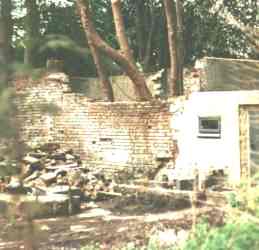|
RURAL
SUPPLY
Initially
cities, then towns benefited from the availability of
electricity for street lighting. Generally, the countryside and villages were without supply
and remained so until the National Grid became
established.

Sycamores
pushing over Coal Bunker
The
exception was larger country estates, where wealthy
landowners had the space and could afford to purchase
the expensive machinery and employ full time engineers.
The 1888 Act also gave the incentive for
supplying the locality and to build up a viable business
enterprise, which could then be sold on at an agreed
value.
It was
thought that many hundreds of examples of the Country
Estate generating station would survive, but in fact a
survey commissioned by English Heritage in 1994 revealed
remarkably few surviving installations.
In no case has the machinery survived to any
degree. The
Old Steam House could equally have disappeared, had its
original use not been discovered and preservation put
into perspective.
To date,
The Old Steam House is the only known example of Country
Estate rural generation this side (south) of London, and
possibly in Europe, but time will tell.
I
remember in late 1982 or early 1983,
a gentleman
who walked his dog in the field next door,
told me that this was the local generating station.
Unfortunately, I didnít note his name, but he
told me that he used to stand on the hill-top between Herstmonceux
village and Lime Park and he could see the lights in a
shop (the bakery) fluctuating in intensity, in time with
the beat of the steam engine.
I havenít seen that gentleman for ten years.
My Local
Authority could not confirm the use of the building or
the reason for the grouping with Lime House.
As late as 1997 the Local Authority believed it
may have been a pump house and indeed it may very well
have pumped water in addition to generating electricity,
for machinery was installed to make ice - but that appears to be a secondary function.
I kept researching for evidence of the original
use of the building.
In July 1997, a friend of
mine, Alex
Askaroff, advised me to visit Ron Saunders, who lived near
Bexhill. Ron
Saunders was 76 when I met him.
He was and remains a market gardener.
He was very clear in his recollection of his time
as a junior gardener in Lime Park.
Ron told how his father, Albert Saunders, was the
chief engineer who ran the steam engine and serviced the
batteries. He
described one room as being filled to ceiling height
with batteries as late as 1936; although, he thought the
steam engine had gone to Herstmonceux Castle.
Herstmonceux
Electricity Generating Works Circa. 1900 - 1936
Introduction
| Instructions
| ISBN
| Batteries
| Boiler
Room | Floor
Plan | Ron
Saunders
Industrial
Revolution
| Lime
Park | Machinery
| Map
| Power
House | Argus
1999
Public
Supply | Roof
Construction | Rural
Supply | Sussex
Express 1913 |
Conclusion
Archaeology
South East
| East
Sussex CC | English
Heritage | SIAS
| Sx
Exp 1999
Memories
of Herstmonceux by Margaret Pollard
|